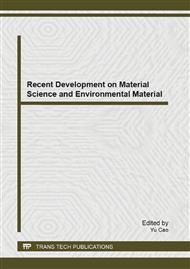[1]
Dewart J M, Bowen B M. Supplementary Documentation for an Environmental Impact Statement Regarding the Pantex Plant. LA-9445-PNTX-D. Los Alamos: Los Alamos National Laboratory, (1982).
DOI: 10.2172/823405
Google Scholar
[2]
Boughton B A, Delaurentis J M. Description and Validation of ERAD: An Atmospheric Dispersion Model for High Explosive Detonations. SAND92-2069-UC-702. Albuquerque: Sandia National Laboratory, (1992).
DOI: 10.2172/10183822
Google Scholar
[3]
Steele C M, Wald T L. Plutonium Explosive Dispersal Modeling Using the MACCS2 Computer Code. LA-UR-98-1901. Los Alamos: Los Alamos National Laboratory, (1998).
DOI: 10.2172/677008
Google Scholar
[4]
Hills C R, Chanin D I. Validation Study of Available Models For Consideration of Explosive Releases at Pantex Plant. RPT-30. Amarillo: Pantex Plant, (1998).
Google Scholar
[5]
Health Physics Society, What About Deadly Plutonium", Position statdopted March 1993. www. hps. org.
Google Scholar
[6]
Anspaugh L R, Shinn J H, Phelps P L. Resuspension and Redistribution of Plutonium in Soils [R]. UCRL-76419. San Francisco: Lawrence Livermore National Laboratory, (1975).
Google Scholar
[7]
Condit R H. Plutonium Dispersal in Fires: Summary of What Is Known [R]. UCRL2ID2114164. San Francisco: Lawrence Livermore National Laboratory, (1993).
DOI: 10.2172/10185271
Google Scholar
[8]
Titus R W. Operation Roller Coaster: Project Officers Report-Project 2. 4 [R]. POR-2504. Washington D.C.: United States Weather Bureau Research, (1965).
Google Scholar
[9]
Gillette D A, Bllfford I H, Fenster C R. Atmospheric-Surface Exchange of Particulate and Gaseous Pollutants [J]. J. Appl. Met, 1972, 11: 977.
Google Scholar
[10]
Shinn J H. Estimation of Aerosol Plutonium Transport by the Dust-Flux Method: A Perspective on Application of Detailed Data [R]. UCRL-78907. San Francisco: Lawrence Livermore National Laboratory, (1976).
Google Scholar
[11]
Shinn J H. Post-Accident Inhalation exposure and Experience with Plutonium [R]. UCRL-JC-131173. San Francisco: Lawrence Livermore National Laboratory, (1998).
Google Scholar
[12]
Shinn J H, Homan D N, Hofmann C B. A Summary of Plutonium Aerosol Studies: Resuspension at the Nevada Test Site. UCRL-90746. San Francisco: Lawrence Livermore National Laboratory, (1986).
Google Scholar
[13]
Shinn J H, Patton S E, Gouveia F J. Seasonal Variations and Frequency Distributions of Plutonium Resuspension at Tonopah, Nevada. UCRL-JC-126286. San Francisco: Lawrence Livermore National Laboratory, (1997).
Google Scholar
[14]
Shinn J H. Assessing Inhalation Exposure from Airborne Soil Contaminants. UCRL-ID-130570. San Francisco: Lawrence Livermore National Laboratory, (1998).
DOI: 10.2172/641115
Google Scholar
[15]
Shinn J H, Homan D N, Hofmann C B. A Summary of Plutonium Aerosol Studies: Resuspension at the Nevada Test Site [R]. UCRL-90746. San Francisco: Lawrence Livermore National Laboratory, (1986).
Google Scholar
[16]
Shinn J H. Assessing Inhalation Exposure from Airborne Soil Contaminants [R]. UCRL-ID-130570. San Francisco: Lawrence Livermore National Laboratory, (1998).
DOI: 10.2172/641115
Google Scholar
[17]
Garcia O A, Iranzo C E. Resuspension and Transport of Plutonium in the Palomares Area. J. Environ. Radioactivity, 1997, 37(1): 101.
DOI: 10.1016/s0265-931x(96)00076-8
Google Scholar
[18]
Shinn J H. Complementary Pu Resuspension Study at Palomares, Spain. UCRL-ID-150980. San Francisco: Lawrence Livermore National Laboratory, (2002).
DOI: 10.2172/15002129
Google Scholar


